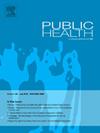The association between walking speeds and osteoarthritis risk based on the National Health and Nutrition Examination Survey and Mendelian randomization study
IF 3.2
3区 医学
Q1 PUBLIC, ENVIRONMENTAL & OCCUPATIONAL HEALTH
引用次数: 0
Abstract
Objectives
To investigate the association between walking speed and osteoarthritis (OA) risk using nationally representative data and Mendelian randomization analysis to infer potential causality.
Study design
A cross-sectional study combined with a two-sample Mendelian randomization analysis.
Methods
Data were obtained from the National Health and Nutrition Examination Survey (NHANES), including information on walking speed, OA status, and covariates. Logistic regression models were used to assess the association between walking speed and OA. A two-sample Mendelian randomization (MR) approach was performed using genome-wide association study (GWAS) summary statistics to explore the potential causal relationship. Sensitivity analyses including heterogeneity and pleiotropy tests were conducted to ensure robustness.
Results
A total of 2027 participants were included. OA patients demonstrated a slower average walking speed (0.9 m/s) compared to non-OA individuals (1.0 m/s). Obesity was significantly associated with OA (OR 1.85, 95 % CI: 1.46–2.33, p < 0.001), and reduced walking speed also showed a strong association (OR 0.23, 95 % CI: 0.16–0.33, p < 0.001). MR analysis supported a causal protective effect of higher walking speed on OA risk.
Conclusions
Faster walking speed is associated with a reduced risk of osteoarthritis, and MR results suggest a potential causal relationship. Walking speed may serve as a modifiable behavioral marker for OA prevention and could inform future public health and clinical strategies.
步行速度与骨关节炎风险之间的关系基于国家健康与营养调查和孟德尔随机研究
目的研究步行速度与骨关节炎(OA)风险之间的关系,采用具有全国代表性的数据和孟德尔随机化分析来推断潜在的因果关系。研究设计:横断面研究结合双样本孟德尔随机化分析。方法数据来自全国健康与营养调查(NHANES),包括步行速度、OA状态和协变量信息。采用Logistic回归模型评估步行速度与OA之间的关系。采用双样本孟德尔随机化(MR)方法,采用全基因组关联研究(GWAS)汇总统计来探索潜在的因果关系。敏感性分析包括异质性和多效性检验,以确保稳健性。结果共纳入受试者2027人。与非OA患者(1.0 m/s)相比,OA患者的平均步行速度(0.9 m/s)较慢。肥胖与OA显著相关(OR 1.85, 95% CI: 1.46-2.33, p <;0.001),步行速度减慢也显示出很强的相关性(OR 0.23, 95% CI: 0.16-0.33, p <;0.001)。MR分析支持高步行速度对OA风险的因果保护作用。更快的步行速度与降低患骨关节炎的风险有关,MR结果表明两者之间存在潜在的因果关系。步行速度可以作为OA预防的一种可改变的行为标记,并可以为未来的公共卫生和临床策略提供信息。
本文章由计算机程序翻译,如有差异,请以英文原文为准。
求助全文
约1分钟内获得全文
求助全文
来源期刊

Public Health
医学-公共卫生、环境卫生与职业卫生
CiteScore
7.60
自引率
0.00%
发文量
280
审稿时长
37 days
期刊介绍:
Public Health is an international, multidisciplinary peer-reviewed journal. It publishes original papers, reviews and short reports on all aspects of the science, philosophy, and practice of public health.
 求助内容:
求助内容: 应助结果提醒方式:
应助结果提醒方式:


